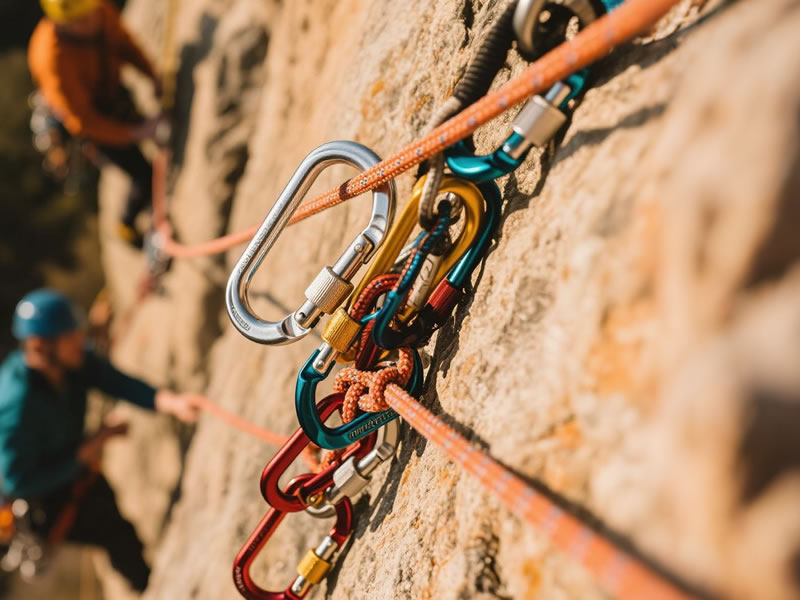Emergency uses for swivel carabiners in climbing
While swivel carabiners aren’t designed for rescue scenarios, their unique rotation capability can solve critical problems when specialized gear is unavailable. Use only UIAA/EN-certified locking swivels (screwgate/triple-action) and retire them immediately after emergency use. Here’s how to deploy them safely when options are limited:

Legitimate Emergency Applications
- Anchor Force Redirection (Non-Load-Bearing)Scenario: Anchor points are misaligned, creating dangerous directional loading.Solution: Clip swivel between anchor and master point carabiner → allows rotation to equalize forces temporarily.Limits: Never exceed 5 kN (swivels lack pulley efficiency).
- Rappel Rope ManagementScenario: Ropes twisted around trees/rocks during retreat.Solution: Attach swivel to rope below obstruction → rotate to unwind tangles.Critical: Backup with friction hitch (Prusik) above device.
- Injured Climber StabilizationScenario: Partner unconscious on ledge; needs attachment to belay station.Solution: Use swivel to connect their harness belay loop to your anchor, allowing rotation to prevent harness twist.Warning: Not for lifting – only prevents positional asphyxia!
- Stuck Rope RetrievalScenario: Jammed rope in cracks after rappel.Solution: Clip swivel to rope tail → rotate to dislodge snags via torsion.
4 Deadly Misuses to Avoid
⚠️ Hauling Systems:
Swivels lack sheaves → friction spikes to 70%+ (vs. 10% for pulleys). A 100kg load requires 700N force → system failure likely.
⚠️ Tyrolean Traverses:
Rotation creates unpredictable oscillation → risks shock loading.
⚠️ Progress Capture:
No cam mechanism → will not hold weight if released.
⚠️ Edge Protection:
Aluminum barrels shatter under rock abrasion → use steel rollers instead.
Step-by-Step: Anchor Extension Case Study
Scenario: Two offset bolts on a crumbling ledge.
- Attach separate slings to each bolt.
- Clip locked swivel (e.g., Petzl Am’D) to both slings.
- Connect master carabiner to swivel’s eye.
- Test: Load gradually ≤5 kN – swivel rotates to equalize.
- Escape immediately – this is not a permanent solution!
Why Swivels Are Risky in Emergencies
| Risk Factor | Consequence |
|---|---|
| Seized rotation | Creates sudden shock loads |
| Minor-axis weakness | Fails at 7 kN (vs. 23+ kN major) |
| Gate flutter | May open under vibration |
| Bearing contamination | Locks mid-operation |
Essential Safety Protocol
- Inspect Before Use:Spin barrel – must rotate freely under load.Check gate lock function.
- Load Limits:Max 5 kN static (≈500kg) – half a climber’s weight.Never use for dynamic loads (falls).
- Backup EVERYTHING:Redundant anchorsFriction hitchesEscape knots
- Post-Use Action:Retire the swivel (internal damage likely).Report incident to manufacturer.
When to Choose Alternatives
- Pulleys: For hauling (>1 kN loads; Petzl Micro Traxion).
- Progress Capture Devices: For raising (Rescucender).
- Edge Rollers: For rope abrasion (Petzl Vertigo).
The Reality Check
Swivel carabiners are temporary crisis tools – not rescue equipment. In 80% of emergencies, a standard locking carabiner is safer. Reserve swivel use for:
- Rotation-specific problems (twisted ropes, anchor alignment).
- Short-duration operations (<10 minutes).
- Situations where NO alternatives exist.
Always prioritize: Carrying a dedicated rescue pulley (e.g., SMC PMP) and practicing improvised techniques before emergencies strike. A swivel might save your life, but understanding its limits saves more.






